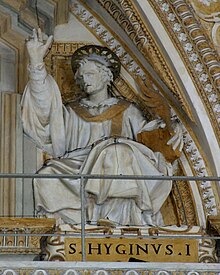Pope Hyginus
Hyginus | |
|---|---|
| Bishop of Rome | |
 Statue of Pope Hyginus in St. Peter's Basilica | |
| Church | Early Church |
| Papacy began | c. 136 |
| Papacy ended | c. 142 |
| Predecessor | Telesphorus |
| Successor | Pius I |
| Personal details | |
| Born | Hyginus |
| Died | 142 Rome, Roman Empire |
| Sainthood | |
| Feast day | 11 January |
Pope Hyginus (Greek: Υγίνος) was the bishop of Rome from c. 138 to his death in c. 142.[1][2] Tradition holds that during his papacy he determined the various prerogatives of the clergy and defined the grades of the ecclesiastical hierarchy.
Hyginus instituted godparents at baptism to assist the baptised during their Christian life. He also decreed that all churches be consecrated. He is said to have died a martyr, though no records verify this. The chronology of the early bishops of Rome cannot be determined with any degree of exactitude today.[3][4]
History
[edit]According to the Liber Pontificalis, Hyginus was a Greek by birth.[3] Irenaeus says that the gnostic Valentinus came to Rome in Hyginus' time, remaining there until Anicetus became pontiff.[5]
Cerdo, another Gnostic and predecessor of Marcion of Sinope, also lived at Rome in the reign of Hyginus; by confessing his errors and recanting, he succeeded in obtaining readmission into the Church but eventually fell back into heresy and was expelled from the Church.[6][7][8][9][10] The Liber Pontificalis also relates that this pope organized the hierarchy and established the order of ecclesiastical precedence (Hic clerum composuit et distribuit gradus).[3] This general observation recurs also in the biography of Pope Hormisdas. According to Louis Duchesne, the writer probably referred to the lower orders of the clergy.[3]
The ancient sources contain no information as to his having died a martyr. At his death he was buried on the Vatican Hill, near Saint Peter's tomb. His feast is celebrated on 11 January.[11][12]
His feast day in the Eastern Orthodox Church is also 11 January.[13]
See also
[edit]References
[edit]- ^ The chronology of these Popes cannot be determined with any degree of exactitude by the help of the extant sources. (Catholic Encyclopedia: Pope St. Hyginus) According to Eusebius (Church History, IV, xv.) Hyginus succeeded Telesphorus during the first year of the reign of Emperor Antoninus Pius, i.e. in 138 or 139. Eusebius (Church History, IV, xvi) states that Hyginus's pontificate lasted four years.
- ^ popes of Rome: from the earliest times to Pius ix, A.D. 1870
- ^ a b c d Kirsch, Johann Peter. "Pope St. Hyginus." The Catholic Encyclopedia. Vol. 7. New York: Robert Appleton Company, 1910. 13 Mar. 2015
- ^ The Object, Importance, and Antiquity of the Rite of Consecration of Churches. ... With ... Notes; and an Appendix, Containing the Consecration Services of Bishop Andrews and of Archbishop Laud, and the Forms of Consecration Adopted by the Convocation of 1712 and 1715, Etc
- ^ On the Detection and Overthrow of the So-Called Gnosis, III, iii
- ^ Butler, Alban. "St. Hyginus, Pope and Martyr", The Lives of the Saints, vol.1, 1866
- ^ Encyclopaedia Perthensis; Or Universal Dictionary of the Arts, Sciences, Literature, &c. Intended to Supersede the Use of Other Books of Reference, Volume 5
- ^ The Complete Idiot's Guide to the Gnostic GospelsBy J. Michael Matkin
- ^ Saint Clement, Pope and Martyr, and His Basilica in Rome
- ^ The Complete Dictionary of Arts and Sciences: In which the Whole Circle of Human Learning is Explained, and the Difficulties Attending the Acquisition of Every Art, Whether Liberal Or Mechanical, are Removed ... The Theological, Philological, and Critical Branches, Volume 2
- ^ Maryknoll Missal: Formerly Published as Daily Missal of the Mystical Body
- ^ New Catholic encyclopedia, Volume 7
- ^ January 24 / January 11. https://www.holytrinityorthodox.com/htc/orthodox-calendar/
External links
[edit] Media related to Pope Hyginus at Wikimedia Commons
Media related to Pope Hyginus at Wikimedia Commons Works by or about Hyginus at Wikisource
Works by or about Hyginus at Wikisource- Opera Omnia (in Latin)
- Fontes Latinae de papis usque ad annum 530 (Papa Felix IV) (in Latin)
- Liber pontificalis (in Latin)
